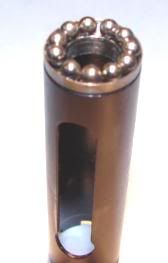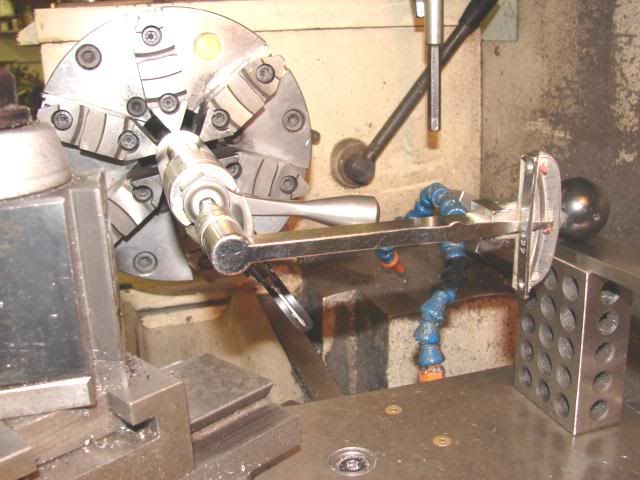Re: DIY savage bolt lift kit...
from savage shooters forum...
[quote author=sharpshooter]
I promised myself I would not interfere anymore in these threds that seemed to have everybody worked up, but now I am going to intervene. It doesn't bother me that you want to tinker and make the world better, however your methods are what got me upset. I apologize for coming off unprofessional, but maybe the following will cast some light where I come from.
Your first idea was very questionable from a safety standpoint, and I am glad that you 86'd it. It raised more questions than answers. Your second idea is more favorable, but it is hardly fresh, as I devised the same thing as soon as the new cocking indicator models came out on the American Classics 2 years ago.
I never bothered posting a picture, frankly because not many were out yet and there was no immediate need. This version uses 11- 3/32" ball bearings in a custom made race.
You have created quite a stir amongst those who want to learn more about this and others who question what your role is. Your "testers" have no established protocol or scope of parameters to lend any credibility to what's going on. It's like the blind leading the blind. Like anything scientific, there are proper and accepted ways to experiment and collect data. I can see where you are lacking in this department and I have decided before this thing gets ugly, I will help you out.
In grade school we had science fairs that were based on experiments of the student's choice, but the format was always the same.This is how is was laid out:
1. OBJECTIVE: decribe what you are attempting to acheive.
2. HYPOTHESIS: decribe what you think will happen with limited observation.
3. METHODS: describe your methods for testing and the equipment you used.
4. RESULTS: report what actually happened supported with data.
5. SUMMARY: summarize the situation explaining why, or why not, the results were different than what was hypothesised.
Over the years I have gathered more than enough data for this, so I will lead by example.
<span style="color: navy">1. OBJECTIVE: to establish a way to reduce the cocking effort required to cycle/cock a Savage rifle by reducing friction.
HYPOTHESIS: by reducing the friction on the bolt assembly screw where it contacts the cocking sleeve on the periphery can reduce the amount of efforts needed to cock and close the bolt.
METHODS: I will use ball bearings as a means of friction reduction and will collect data using torque values gathered with a Sturtevant Richmont inch/lb beam style torque wrench, model M 50-1. To eliminate as much human error as possible, I will chuck the action in a lathe chuck and support the torque wrench with a solid support to get consistant reading.All tests will use a bolt assembly screw shortened the same amount of what the bearing will take up.
RESULTS: The data collected here was derived from 36 different actions representing a cross section obtained from specimens manufactured from approximately 1997 to 2008. These numbers represent the average of operations.
COCKING EFFORT: 22.30 in/lbs.
CLOSING EFFORT: 13.5 in/lbs.
OPENING EFFORT(already cocked): 17.9 in/lbs.
</span><span style="color: purple">notes: The hardest to cycle measured in @30 in/lbs, the esiest @ 18 in/lbs. I consider these to be the extreme, with most being in the 20 in/lbs range.</span>
The following data was collected from 1 speciman using the 2 types of bearings to reduce friction.
<span style="color: black"> Efforts involved in cycling operation
Observations made on a Savage model 116 serial# G893xxx
1.operation. 2.before mod(stock). 3.w/single centered ball bearing. 4.w/ thrust bearing. 5.Trued&timed w/no mod. 6.Trued&timed w/thrust bearing. 7.Trued &timed w/single centered ball bearing.</span>
<span style="color: red">1. 2. 3. 4. 5. 6. 7.</span>
cocking effort 20 in/lbs. 18 19 14 13 12
closing effort 16 14 15 10 8 8
re-open effort 16 14 15 12 10 9
<span style="color: purple">SUMMARY: These tests conclude that a single centered ball bearing reduces more friction that multiple ball thrust bearing. Other factors besides friction affect the efforts of cycling due to the variant geometry of the various components of the fire control system. This test does not address the several other points of friction that also contribute to cycling efforts. The trued & timed action was included in this test to demonstrate the the consistancy of what a single centered ball would reduce in friction only. It appears through this test and many others that I have checked to reduce all the cycling efforts only by 2 in/lbs.</span>
This data was collected long before I publicly shared the idea of the ".38 case and ball bearing tip". Before that, I made the first ones turning a steel "case" and drilled it for a ball bearing. Although it was more precise, it did not work any better than an old .357 case cut down and a ball bearing expoxied in the primer pocket. It was alot less work, not to mention cheap. As far as shortening the bolt assembly screw, it is less work than fabricating a spacer of specific size, although the spacer will work.
These are my findings; like it or not, you don't have to take my word for it, so feel free to do what ever you want. It took quite some time for me to dig out all my notes and compile this, so I hope you appreciate it.
[/quote]











